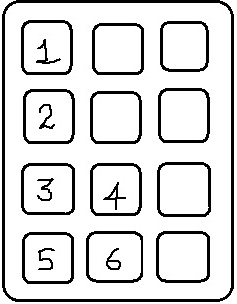Image Zooming
Project by Aditya Udaya Barve and Malavika Nuggehally Prasanna
Objective
To display the various zoomed parts of an image using Nokia LCD 6100, SD Card and a touchpad.
Description
In this project, we have interfaced Nokia LCD, MPR121 capacitive touch sensor and an SD card system to MBED. The image as well as the various zoomed parts of it are stored in an SD Card. On pressing a particular touch sensor key, a particular zoomed portion is displayed on a Nokia LCD.

A reduced schematic of the touch key pad is as shown above.On pressing Key 1, the original image is displayed. On pressing key-2, the zoomed version of the original image is displayed. Keys 3, 4, 5 and 6 correspond to the top left, top right, bottom left and bottom right zoomed portions of the original image respectively. All the images are read from the SD card system and displayed on a Nokia LCD.
All the images are loaded into the micro SD card in a directory. The images are stored in bmp format. The interfacing of SD card system to the MBED is described in SD Card.
The inputs for selecting the images is done by capacitive touch sensor MPR121 from freescale. The interfacing of this is described in capacitive touchpad. The keys pressed are read using I2C interface and triggered by a digital interrupt.
Finally, the selected image is displayed on a Nokia LCD. The interfacing is described in Nokia LCD.
The displaying of bmp files is done using set of functions described in the "myBMP.cpp" file. The file was adopted from EasyBMP library.
Picture of the project

Video Demonstration of the project
Components
- Mbed NXP LPC1768
- SD Card
- MPR121 Capacitive Touch Pad
- Nokia LCD 6100
Connections

Code for the project
Import programimage_zooming
This is a code which generates the various zoomed versions of an image stored in an SD card and displays it on a Nokia LCD based on the keys pressed on a capacitive touch pad.
Limitations and Future Scope
- The original idea was to implement persistence of vision by flipping through the images so fast that it will be perceived as an animation. Due to the limits of speed of writing of an image on the Nokia LCD, we could not implement the feature.
- The above limitation can be approached as follows:
- By playing around with the way in which an image can be written into an LCD.
- By trying to use a different kind of interface to write an image into the LCD.
- By adjusting the baud rate of SPI interface through which the image is written into an LCD.
- By being open to the idea of not using a serial interface and trying to implement some kind of parallel protocol.
- Zooming of any image on the fly can be implemented.
References
Please log in to post comments.
